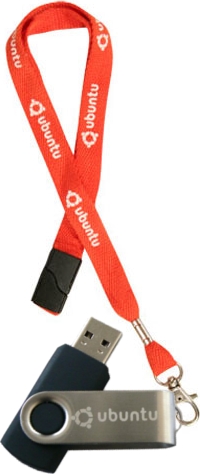Lanyard
Lanyard is a cord or strap worn around the neck, shoulder, or wrist to carry objects. Traditionally, lanyards were used in the military to connect a pistol, sword, or whistle to a uniform semi-permanently. Lanyards have evolved into decorative and functional items, used in various settings from schools and businesses to trade shows and military units. They serve multiple purposes, including holding identification cards, keys, and electronic devices, promoting businesses or brands, and ensuring items are easily accessible and less likely to be lost.
History[edit | edit source]
The term "lanyard" originates from the French word lanière, meaning strap or thong. The use of lanyards dates back to the 15th century, primarily in the military for securing items such as whistles, swords, and pistols to the body. This was crucial in battle situations where soldiers needed to prevent losing their weapons or tools. Over time, the application of lanyards extended beyond the military, becoming popular in the civilian realm for various practical and decorative purposes.
Types of Lanyards[edit | edit source]
Lanyards come in different materials, including nylon, polyester, and cotton, and can feature various attachments like hooks, clips, and badge holders. The choice of material and attachment often depends on the intended use of the lanyard. Some common types of lanyards include:
- Neck Lanyards: Worn around the neck to hold ID cards, badges, or keys. They are commonly used in schools, offices, and public events.
- Wrist Lanyards: Smaller than neck lanyards and worn around the wrist, ideal for carrying items like keys or small tools.
- Custom Lanyards: Designed with specific logos, colors, or messages to promote brands, events, or organizations.
- Safety Lanyards: Used in safety equipment, particularly in construction and industrial settings, to prevent falls or secure tools.
Uses of Lanyards[edit | edit source]
Lanyards have a wide range of uses, from functional to promotional. In a professional setting, they are often used to display identification badges or access cards, enhancing security by making it easy to identify authorized personnel. In personal use, lanyards can keep small items like keys or USB drives handy and reduce the risk of loss. Additionally, lanyards serve as promotional items, with companies and organizations customizing them with logos, slogans, or colors to increase brand awareness.
Design and Customization[edit | edit source]
The design and customization of lanyards are important aspects, especially for promotional and branding purposes. Companies can choose from a variety of colors, materials, and printing methods to create a lanyard that reflects their brand identity. Common customization options include silk screen printing, dye sublimation, and woven designs, each offering different benefits in terms of durability and visual appeal.
Safety Considerations[edit | edit source]
While lanyards are generally safe to use, there are safety considerations, especially in environments with machinery or when used in physical activities. Breakaway lanyards, which detach under pressure, are recommended in situations where there is a risk of the lanyard getting caught or entangled, reducing the risk of injury.
Conclusion[edit | edit source]
Lanyards are versatile accessories that serve various purposes across different sectors. From their historical military use to their modern applications in business, education, and personal use, lanyards have become ubiquitous items for carrying, displaying, and promoting. With the ability to customize and design them according to specific needs, lanyards continue to be a popular choice for practical and promotional uses.
| This article is a stub. You can help WikiMD by registering to expand it. |
Search WikiMD
Ad.Tired of being Overweight? Try W8MD's physician weight loss program.
Semaglutide (Ozempic / Wegovy and Tirzepatide (Mounjaro / Zepbound) available.
Advertise on WikiMD
|
WikiMD's Wellness Encyclopedia |
| Let Food Be Thy Medicine Medicine Thy Food - Hippocrates |
Translate this page: - East Asian
中文,
日本,
한국어,
South Asian
हिन्दी,
தமிழ்,
తెలుగు,
Urdu,
ಕನ್ನಡ,
Southeast Asian
Indonesian,
Vietnamese,
Thai,
မြန်မာဘာသာ,
বাংলা
European
español,
Deutsch,
français,
Greek,
português do Brasil,
polski,
română,
русский,
Nederlands,
norsk,
svenska,
suomi,
Italian
Middle Eastern & African
عربى,
Turkish,
Persian,
Hebrew,
Afrikaans,
isiZulu,
Kiswahili,
Other
Bulgarian,
Hungarian,
Czech,
Swedish,
മലയാളം,
मराठी,
ਪੰਜਾਬੀ,
ગુજરાતી,
Portuguese,
Ukrainian
Medical Disclaimer: WikiMD is not a substitute for professional medical advice. The information on WikiMD is provided as an information resource only, may be incorrect, outdated or misleading, and is not to be used or relied on for any diagnostic or treatment purposes. Please consult your health care provider before making any healthcare decisions or for guidance about a specific medical condition. WikiMD expressly disclaims responsibility, and shall have no liability, for any damages, loss, injury, or liability whatsoever suffered as a result of your reliance on the information contained in this site. By visiting this site you agree to the foregoing terms and conditions, which may from time to time be changed or supplemented by WikiMD. If you do not agree to the foregoing terms and conditions, you should not enter or use this site. See full disclaimer.
Credits:Most images are courtesy of Wikimedia commons, and templates Wikipedia, licensed under CC BY SA or similar.
Contributors: Prab R. Tumpati, MD




